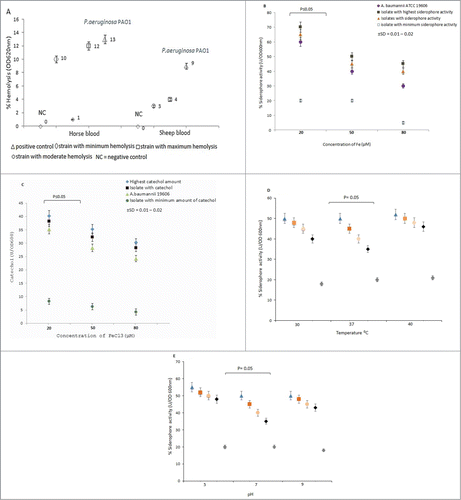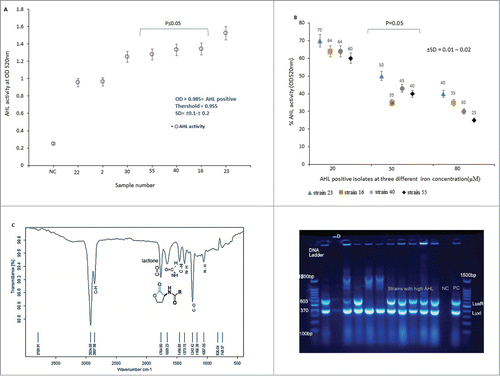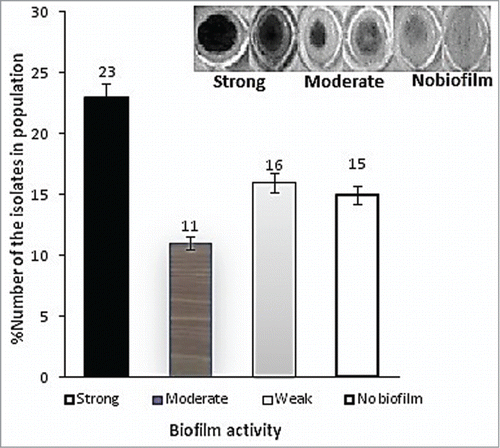Figures & data
Table 1. Antibiotic susceptibility of A. baumannii isolated from ICU patients in 2 main hospitals in Kerman, Iran to 16 antibiotics
Figure 1. (A) Comparative hemolytic activity of A. baumannii isolates in the presence of defibrinated sheep and horse red blood cells. NC = negative control (medium without bacteria), P.aeruginosa PAO1 = positive control showing hemolysis. The percent hemolysis in supernatant was measured at OD620 nm. Values represent the mean (± SD) of 3 independent experiments. (B) Quantification of siderophore in A. baumannii isolates in 3 different Fe concentrations. Values are expressed as percentage of siderophore units (U) normalized to the cell density OD600nm of bacterial culture. † = values are the means for a representative assay performed in triplicate. (C) Quantification of catechol groups in 3 different Fe concentrations. Presence of catechol groups in the supernatants of the A. baumannii isolates was detected by the Arnow test. Iron-chelating activity in culture supernatants of A. baumannii strains grown in Fe-limited medium showed with different color. A P ≤ 0.05 was considered as statistically significant for 2-tailed tests. (D and E) Effect of temperature on siderophore activity and pH on siderophore activity.

Figure 2. (A) N-acyl homoserine lactone (AHL) activities of A. baumannii isolates collected in this study. Threshold for AHL production is shown in the graph. NC = negative control. Intensity of color was measured at OD520nm.The results are mean of 3 simultaneous experiments. A P ≤ 0.05 was considered as statistically significant for 2-tailed tests. (B) Effect of iron-III concentrations on AHL activity in A. baumannii. Error bars represent the standard errors of the means for a representative assay performed in triplicate. X axis indicates A. baumannii isolates that showed a high and low AHL. (C) FT – IR spectra of AHL produced by A. baumannii isolates. The AHL was extract from organism by LLE- methods as described in the text. The pure compound was then subjected to FT-IR spectroscopy. The lactone ring and amide group were shown at 1764.69cm−1 and 1659.23cm−1 wave number. (D) Detection of LuxI (370 bp) and LuxR (603 bp) quorum sensing genes in A. baumannii isolates by multiplex-PCR. Electrophoresis was carried out in 1% agarose gel for 2 h at 80 V, the gel was stained with tracking dye (Syber green).

Figure 3. (A) Biofilm formation of A. baumannii isolates investigated in this study. The above results are average of 3 OD reading at 570nm.The amount of biofilm remaining was determined by the absorbance of the crystal violet dye.Citation39 Error bars represent the standard deviation from the mean of 3 observations. A standard culture of P. aeruginosa PAO1 was used as positive control. Growth was expressed as percentage relative to the untreated control.

Table 2. Effect of iron-III concentrations on AHL, siderophore and biofilm formation by A.baumannii isolates investigated in this study
